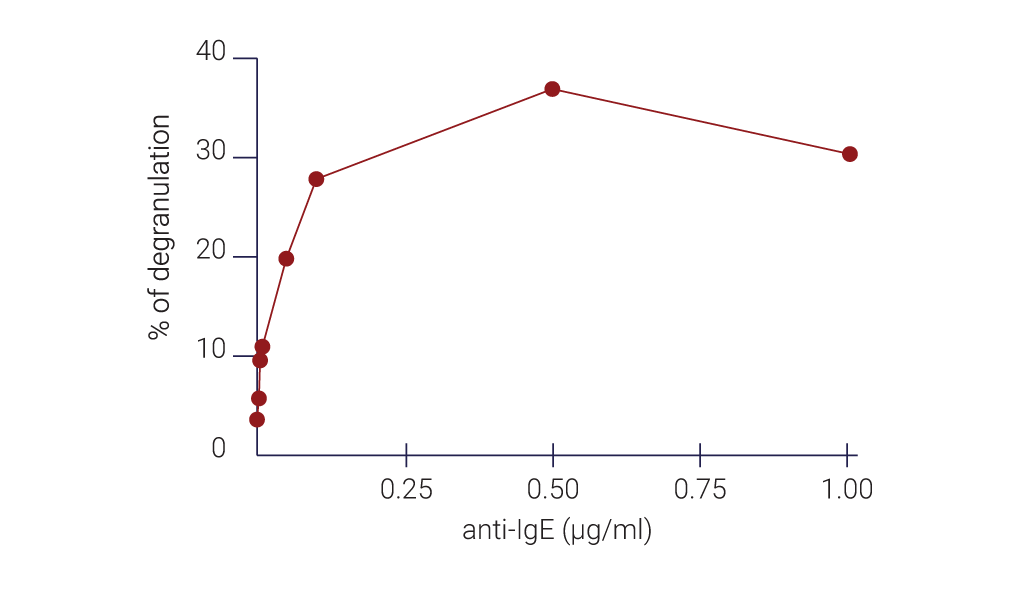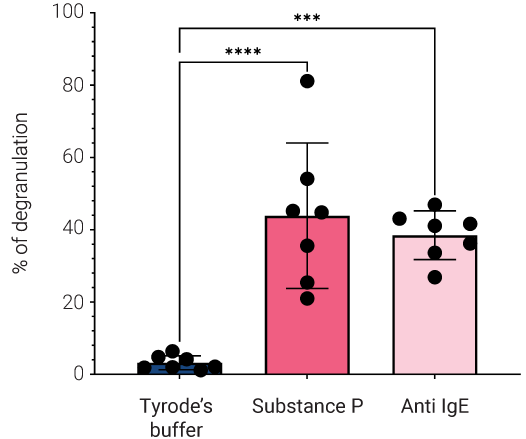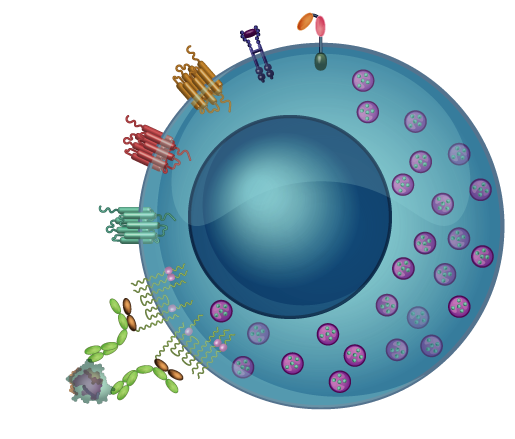Human Primary Mast Cells
Evaluate in vitro mast cell response
Human Primary Mast Cells for Research
Reliable human data on drug efficacy & toxicity

Today’s research on new drugs is often complicated by a consistent lack of relevant study tools. This is also the case when it comes to research on mast cells, where rodent and human cell line models are still the standard and human primary mast cells remain notoriously hard to obtain. Genoskin provides a reliable solution to help you study human primary mast cell response to your compound or formula. You’ll find a quick overview of our offer below.
In Vitro
Genoskin provides unique access to connective-tissue type human primary mast cells for drug candidate screening.
Human
Our research consistently focuses on human tools to generate reliable data on your compound or formula.
Mast Cells
Mast cells are immunological key players in a wide range of pathologies, including allergic reactions.
For Research
Our mast cells are designed for in vitro research on drug efficacy and toxicity.
Human Primary Mast Cells
Key players in immunology
Mast cells play an important role in how the immune system responds to certain bacteria and parasites and they also help control other types of immune responses. They have been mostly viewed as effectors of allergy and it has only been in the last two decades that they have gained significant attention for their involvement in a range of other physiological and pathological processes. Mast cells are a type of white blood cell found in connective tissues throughout the human body. Investigations have shown that they are present in the skin and in nearly all vascularized organs, including heart, lungs, kidneys, intestine, liver and in the brain side of the blood-brain barrier. They contain chemicals such as histamine, heparin, cytokines, and growth factors, which they release during allergic reactions and certain immune responses (Sarit Pal et al., 2020).
First-in-human data on drug efficacy and toxicity
A unique platform to de-risk drug development




As human primary mast cells are notoriously hard to obtain for research purposes, Genoskin has developed a unique process using peripheral blood samples from healthy adult donors. This 1-month process yields mature mast cells that show the same metabolism and expression as the mast cells in the human body, with the phenotype of connective tissue-type mast cells:
- The granules are filed with heparin, tryptase and chymase
- They express the high affinity receptor for IgE (FcɛR1⍺), MRGPRX2 (specifically expressed by skin mast cells), FcgRs and many G protein-coupled receptors including receptors for complement anaphylatoxins
- They can degranulate and produce cytokines/chemokines in response to many stimuli including IgE/anti-IgE, cationic molecules that bind to MRGPRX2 (e.g neuropeptide substance P and FDA-approved drugs), C3a and C5a, endothelin-1,…


First-in-human data on drug efficacy and toxicity
A unique platform to de-risk drug development




As human primary mast cells are notoriously hard to obtain for research purposes, Genoskin has developed a unique process using peripheral blood samples from healthy adult donors. This 1-month process yields mature mast cells that show the same metabolism and expression as the mast cells in the human body, with the phenotype of connective tissue-type mast cells:
- The granules are filed with heparin, tryptase and chymase
- They express the high affinity receptor for IgE (FcɛR1⍺), MRGPRX2 (specifically expressed by skin mast cells), FcgRs and many G protein-coupled receptors including receptors for complement anaphylatoxins
- They can degranulate and produce cytokines/chemokines in response to many stimuli including IgE/anti-IgE, cationic molecules that bind to MRGPRX2 (e.g neuropeptide substance P and FDA-approved drugs), C3a and C5a, endothelin-1,…


Biological validation
Fully mature & functional mast cells


Genoskin’s mature connective-tissue type mast cells (CTMCs) are fully differentiated. Their heparin-filled granules can be specifically stained with Avidin, similar to what is observed with CTMCs in the skin. As shown in the graphs below, FcɛR1⍺ & MRGPRX2 are functional and display normal activity upon stimulation. To obtain these results, ß-hexosaminidase activity was measured in the culture supernatant.
ß-hexosaminidase assay


Upon stimulation of the FcɛR1⍺ receptor with an IgE agonist antibody, ß-hexosaminidase activity can be detected in the culture supernatant (30k cells/well in 100 µl).


Upon stimulation of the MRGPRX2 receptor with substance P, ß-hexosaminidase activity can be detected in the culture supernatant (30k cells/well in 100 µL).
Pharmacological validation
Mast cell degranulation & dose-effect experiments




Genoskin’s in vitro primary mast cells degranulate upon stimulation with compounds known to trigger mast cell degranulation. The platform also allows to perform dose-effect experiments.


Drug candidate screening services
Efficacy & Toxicity Research Platforms


Our human primary mast cells are suitable for in vitro drug efficacy and toxicity screening using human mast cell response to drugs and compounds. Below, you’ll find the types of studies you can conduct with Genoskin’s human primary mast cell platform, which allows the following assays:
β-hexosaminidase assays
Histamine assays
Cytokine release analysis
Drug efficacy studies
Inhibition of mast cell degranulation
Drug toxicity assessment
Activation of mast cell degranulation
Would you like to take your research even further ?
Study mast cell activation in situ


If you’re looking for other options to study mast cell activation, we may have just what you need. All our data generation platforms are designed to offer reliable first-in-human data prior to clinical trials. To take your mast cell research to the next level, studying mast cells in situ may be an interesting approach. Below you’ll find two platforms that help you do just that.
Relevant Scientific Publications
Literature on mast cells by Dr. Gaudenzio, our CSO




Below you’ll find relevant literature on mast cells by our Chief Scientific Officer and immunology expert, Dr. Nicolas Gaudenzio.
September 2016 - Different activation signals induce distinct mast cell degranulation strategies
- Different activation signals induce distinct mast cell degranulation strategies
- Published in The Journal of Clinical Investigation – September 19, 2016
- Nicolas Gaudenzio, Riccardo Sibilano, Thomas Marichal, Philipp Starkl, Laurent L. Reber, Nicolas Cenac, Benjamin D. McNeil, Xinzhong Dong, Joseph D. Hernandez, Ronit Sagi-Eisenberg, Ilan Hammel, Axel Roers, Salvatore Valitutti, Mindy Tsai, Eric Espinosa, and Stephen J. Galli.
- Published in The Journal of Clinical Investigation – September 19, 2016
March 2013 - Human mast cells drive memory CD4+ T cells toward an inflammatory IL-22+ phenotype
- Human mast cells drive memory CD4+ T cells toward an inflammatory IL-22+ phenotype
- Published in The Journal of Allergy and Clinical Immunology – March 20,2013
- Nicolas Gaudenzio, PhD, Camille Laurent, MD, Salvatore Valitutti, MD, Eric Espinosa, PhD
- Published in The Journal of Allergy and Clinical Immunology – March 20,2013






